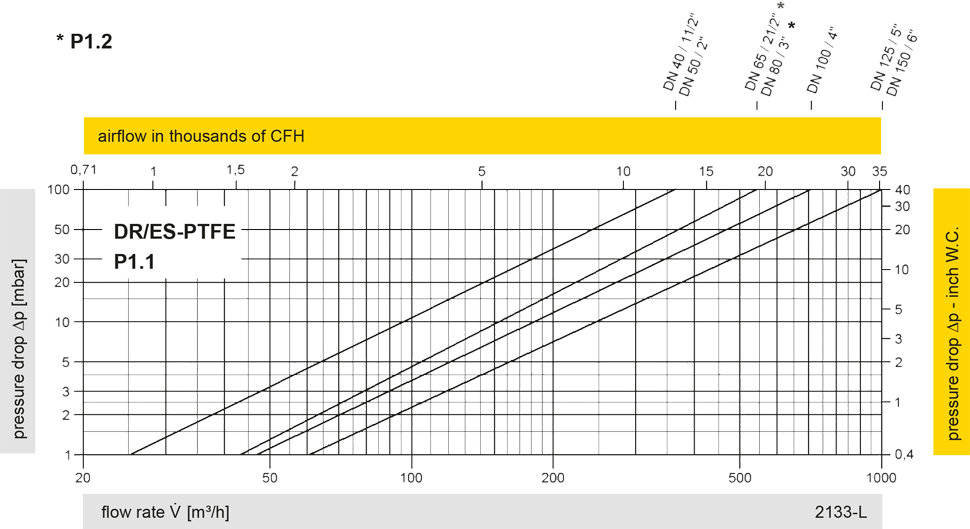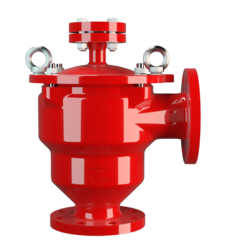DR/ES-PTFE
In-Line Detonation Flame Arrester for stable detonations and deflagrations in right angle design with shock absorber, unidirectional
- build up of adhesive materials is prevented by the smooth surfaces
- minimum number of FLAMEFILTER® discs due to the effective shock absorber
- quick removal and installation of the complete PROTEGO® flame arrester unit and the individual FLAMEFILTER® discs in the cage
- the modular design enables each individual FLAMEFILTER® discs to be replaced
- offers protection against deflagrations and stable detonations
- the right angle design saves pipe elbows
- ideal for corrosive media
- less soiling of the device lowers service, operating and life-cycle cost
Função e descrição
The PROTEGO® DR/ES-PTFE series in-line detonation flame arrester is distinguished by its unique resistance to adhesive and corrosive media. The use of fluoroplastics as a high-tech housing coating and as safety flame arrester element is unique throughout the world. The device represents a further development of PROTEGO® flame arresters DR/ES in a right angle design that have been used and proven for decades in industry. The device protects against deflagrations and stable detonations.
Once a detonation enters the flame arrester, energy is absorbed from the detonation shock wave by the integrated shock absorber (1) before the flame is extinguished in the narrow channel of the PTFE FLAMEFILTER® (3).
The PROTEGO® flame arrester unit (2) consists of several FLAMEFILTER® discs and spacers firmly held in the FLAMEFILTER® cage (4). The gap size and number of FLAMEFILTER® discs are determined by the operating data parameters of the mixture flowing in the line (pressure, temperature). The detonation arrester can be used for explosion group IIA (NEC group D). The standard design is approved at an operating temperature up to +60°C / 140°F and an absolute operating pressure acc. to table 3.
EU conformity according to the currently valid ATEX directive. Approvals according to other national/international regulations on request.
Tabela de dimensões
Para selecionar o diâmetro nominal (DN), utilize os diagramas de vazão nas páginas seguintes
| DN | 40 / 1 ½" | 50 / 2" | 65 / 2 ½" | 80 / 3" | 100 / 4" | 125 / 5" | 150 / 6" |
| a | 153 | 155 | 198 | 200 | 250 | 332 | 335 |
| b | 183 | 185 | 223 | 225 | 290 | 357 | 360 |
| c | 335 | 335 | 420 | 420 | 490 | 590 | 590 |
| c1 | 455 | 455 | 585 | 585 | 680 | 835 | 835 |
| d | 210 | 210 | 275 | 275 | 325 | 460 | 460 |
| e | 685 | 685 | 770 | 770 | 840 | 940 | 940 |
Seleção do material do corpo
| Versão | A |
| Corpo | Aço com revestimento em ECTFE |
| Tampa com absorvedor de choque | Aço com revestimento em ECTFE |
| Vedação | PTFE |
| Conjunto abafador de chamas | A, B, C |
Combinações de material do conjunto abafador de chamas
| Versão | A | B | C | |
| Armação do jogo de FLAMEFILTER® | PTFE* | Hastelloy | Aço inoxidável | |
| FLAMEFILTER®* | PTFE* | PTFE* | PTFE* | |
| Espaçadores | PEEK / ETFE / FEP | PEEK / ETFE / FEP | PEEK / ETFE / FEP |
Seleção do grupo de explosão
| MESG | Gr. expl. (IEC / CEN) | Grupo gás (NEC) |
| > 0,90 mm | IIA | D |
Seleção da pressão máx. de trabalho
| DN | 40 / 1 ½" | 50 / 2" | 65 / 2 ½" | 80 / 3" | 100 / 4" | 125 / 5" | 150 / 6" | ||
| Expl. Gr. | IIA | Pmax | 1,1 | 1,1 | 1,2 | 1,2 | 1,1 | 1,1 | 1,1 |
Indicação da temperatura máx. de trabalho
| ≤ 60°C / 140°F | Ttemperatura máxima de trabalho admissível em °C |
| - | Designation |
Tipo de conexão flangeada
| EN 1092-1; Form B1 |
| ASME B16.5 CL 150 R.F. |
Versão e especificação
There are two different designs available:
Corta-chamas à prova de detonação em linha em Versão básica | DR/ES - PTFE – |
Corta-chamas à prova de detonação em linha com sensor de temperatura* integrado como proteção adicional contra combustão de curta duração | DR/ES - PTFE - T |
*Termoresistência para grupo de equipamentos II, categoria (1) 2 (cat. GII (1) 2)
Diagrama de vazão

Este diagrama de vazão foi determinado em uma bancada de medição de vazão calibrada e certificada pela TÜV. A vazão V em m³/h se refere ao estado técnico padrão de ar, conforme ISO 6358 (20°C, 1bar). Para conversão em outras densidades e temperaturas, veja o cap. 1: Bases técnicas.


